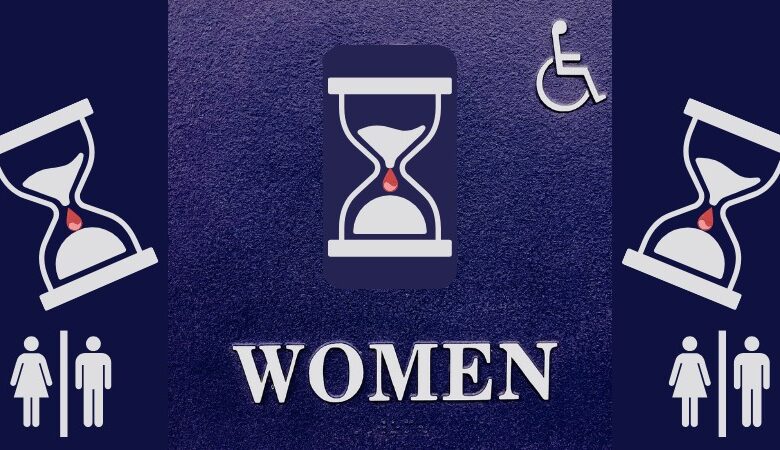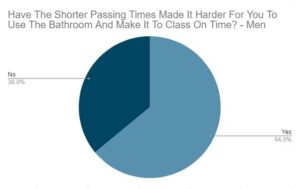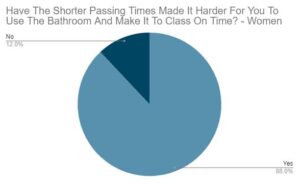Are Short Passing Times Sexist?
How the switch to 5-minute passing times disproportionately disadvantages female students

The new Trimester schedule has brought about a long list of changes to a student’s daily schedule; however, the short five-minute passing times have been the topic of discussion for many students of BHS.
The most obvious challenge with shorter passing times is being able to use the bathroom. On average, without any hallway traffic, a walk from the A-wing to the C-wing of the school takes 1 minute and 48 seconds. If a student needs to go up or down a flight of stairs, that walk time increases to 2 minutes. This leaves only 3 minutes to use the bathroom, and that doesn’t include the hundreds of students coming from music, health, phy ed, art, or tech ed classes each passing time. Walking into the door as the bell rings isn’t good enough either, as many teachers expect their students to be fully set up by the time class officially begins. Students are also discouraged from packing up early to prepare for the sprint.
On top of this difficulty, BHS administration has implemented a new policy that doesn’t allow students to use the restroom during the first or last 10 minutes of a class. Adhering to this rule takes away yet another 20 minutes from the already shortened class times that students are allowed to use the restroom each hour. In total, if students are missing passing time to use the restroom, this leaves 25-minutes between the next chance to go.
Having two fewer minutes to use the restroom than last year means this change has impacted almost every student. However, this new rule breaks the school’s promise of equity by unfairly impacting one group of students.
According to the US Department of Education, sexism in schools can occur when a student faces greater challenges due to their sex. With this definition in mind, the question for BHS is: does the shorter passing time pose a greater challenge to one sex?
50 randomly selected students – 25 young men and 25 young women – were surveyed on whether this new passing time has made it harder for them to use the bathroom and still make it to class on time. Sixteen of the 25 male students (64%) said that they had experienced this problem, whereas 22 of the 25 female students (88%) said they were having difficulties. Even Freshman, who have had shorter passing time at the middle school are experiencing more problems at the high school level, with 89 out of 104 people (86%) citing issues.

These results show that something is definitely off. But why? If there are roughly the same amount of men and women in the school, why aren’t more male students facing this challenge? Shouldn’t it be equally difficult for everyone to use the restroom? Well, unsurprisingly for the women reading this article, using the bathroom is always a more time-consuming task.
.

The lines for the women’s restrooms are much longer than the ones for men’s rooms. This is because while the average women’s bathroom only has three toilets, the average men’s bathroom has three urinals and two toilets, allowing for more people to go at once and the lines to flow faster. Women also generally require more toilet paper than men, which causes the pipes to face more blockage and disgusting leaks, which can lead to extended periods of time where they are out of order.
However, the biggest factor of the bathroom discrepancy is that a majority of male students can generally wait longer to use the restroom. Many decide to wait until they get home. Most women, though, do not have this option. Many female high school students are currently menstruating, which is something that – contrary to popular belief – cannot be simply held in. Why are more women using school toilets? Because they are forced to. Bathroom access is necessary for all menstruating students, as misuse of feminine hygiene products (i.e. not changing them at the proper time) can lead to a wide array of health problems, one of which is deadly TSS (toxic shock syndrome).
It is also important to note that women’s restrooms aren’t the only ones with long wait times. The gender-neutral bathrooms at BHS are few and far between. Students who require these bathrooms arguably face even more difficulties with long lines, and if they need to change a pad or tampon after that wait, getting to class on time can become an impossible task.
Students aren’t the only ones facing these challenges. Many teachers are struggling to use the restroom in the short time allotted, and leaving a class unattended for a bathroom break is not a within-the-rules option. Teachers also use gender-neutral bathrooms which, as previously mentioned, are nearly impossible to get into. 83% are citing newfound issues getting to the restroom.
So does this new policy disproportionately affect female students? Simply put, the answer is a resounding yes. However, it is important to note that while some students are impacted more than others, this change has had a negative effect on everyone. Some men say that they can wait until they get home to use the bathroom, but this wait is unhealthy and can be dangerous. Students can become dehydrated or face different infections in the quest to get to class on time. While efficiency and productivity are both important traits, the safety and well-being of all students should not be compromised.
If the school administration wants to prioritize or simply acknowledge the health of their students, they should look into extending passing times and giving more leeway to students who are late to class. Bathroom access is a basic human right that all people should be able to have available to them.




